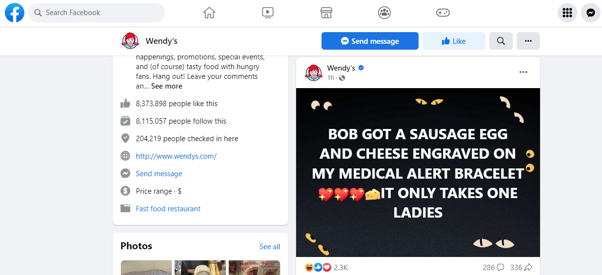It’s no secret that we’re all pretty much living online these days. You know how it is – you send a quick tweet while waiting for your morning coffee, upload a snapshot of your lunch to Instagram, and then end your day with a quick scroll through your LinkedIn feed.
The rich history of social media showcases its ever-changing nature and its profound impact on how individuals and businesses connect, communicate, and thrive in the digital era. What is the line between our digital and physical lives? It’s gotten so blurry that it’s almost nonexistent.
But this cybernetic landscape isn’t just about sharing selfies or watching cute cat videos. Oh no, it’s become so much more than that, especially for businesses.
Social media marketing is a powerful tool to help startups shine bright amidst the fierce competition. In this article, we will roll up our sleeves and get into the nitty-gritty of social media marketing, showing you how to play this game to win. It’s time to turn likes into leads, and shares into sales!
What Is Social Media Marketing
Social media marketing refers to using social media platforms to create and distribute engaging content to achieve marketing and business objectives. It involves utilizing various social media channels, such as Facebook, Instagram, Twitter, LinkedIn, and YouTube to:
- Build brand awareness
- Engage with the audience
- Drive website traffic, and
- Ultimately convert followers into customers.
It encompasses activities such as sharing engaging content, interacting with followers, analyzing results, and running social media ads.
How Does Social Media Marketing Work
The dynamism of the startup ecosystem calls for a well-defined approach to business, especially in terms of marketing. Social media marketing is a key component of this approach, with its vast reach and customizable features. Let’s consider each aspect in detail, using real-world examples for better understanding.
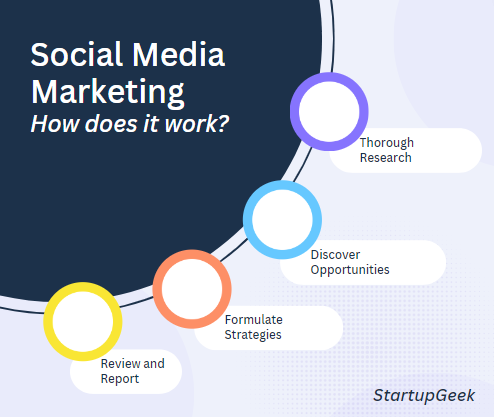
Research
Let’s imagine your startup is a vegan food delivery service. In this stage, you’d use social media to understand your audience’s preferences – are they more interested in ready-to-eat meals or meal kits? You’d also track your competitors – what are they offering, and how are they engaging with their customers?
For example, by following companies like Beyond Meat and Purple Carrot, you could glean insights into successful marketing techniques and customer interactions.
Discover Opportunities
By monitoring social media trends and conversations, you could discover untapped opportunities. Let’s say your research reveals a rising interest in gluten-free vegan options; this could be an opportunity for you to introduce a new product line.
A practical example is how Oatly, the oat milk company, saw the dairy-free trend on social media and seized the opportunity to expand its brand reach.
Formulate Strategies
Once you’ve found your opportunity, it’s time to strategize. Aligning with our vegan startup example, you might decide to partner with fitness influencers, knowing your target audience cares about health and wellness.
Example: You could take inspiration from companies like Gymshark, which has strategically leveraged influencer marketing to skyrocket its brand’s growth.
Review And Report
Here, you measure the success of your strategies. Tools like Sprout Social or Hootsuite provide in-depth analytics on post engagement, audience growth, and more. Say your influencer posts aren’t generating the expected engagement; this feedback allows you to adjust your approach.
For example, Buffer, a social media management tool, regularly shares their performance data and adjusts their marketing strategies based on these insights.
Benefits Of Social Media Marketing

- Increased brand awareness: Social media sites provide a vast audience and allow businesses to reach many potential customers. By establishing a strong presence and sharing engaging content, businesses can raise brand awareness and reach new audiences.
- Enhanced customer engagement: Social media provides an interactive platform for businesses to connect and engage with their customers. Through comments, likes, shares, and direct messages, businesses can build relationships, gather feedback, and address customer inquiries promptly.
- Targeted social media advertising: Social media platforms offer sophisticated targeting options, allowing businesses to deliver their messages to specific demographics, interests, and behaviors. This precision targeting helps optimize ad spend and ensures that ads are seen by the right audience.
- Increased website traffic and conversions: Social media can be a powerful driver of website traffic. By sharing compelling content and strategically placing links, businesses can direct users to their websites and increase the chances of conversions, such as sales, sign-ups, or downloads.
- Competitive advantage: With social media becoming increasingly prevalent, businesses engaging in social media marketing trends can gain a competitive edge. By staying visible, relevant, and responsive on social media, businesses can differentiate themselves from competitors and stay top of mind for customers.
Why Does Digital Marketing Hold Greater Value For Startups?
Social media is the ultimate superpower for startups! It’s like having a secret weapon that boosts brand awareness and generates leads, all while keeping your budget intact.
It’s not just a channel you should consider; it’s a channel you absolutely must utilize. In fact, it has transformed into the go-to platform for connecting with your target audience and placing your brand right in their line of sight.
Even though, on a daily basis, numerous ideas are generated by individuals, yet only a few of them transform into startups. However, unlike established businesses, startups require concentrated and precise dedication.
In essence, startup marketing poses a distinct challenge due to the limited resources startups typically have, such as time, money, and talent.
According to Statista, worldwide digital advertising spending was estimated at $522.5 billion in 2021. Projections suggest that this spending will reach $836 billion by 2026.
These figures speak volumes and make a solid case for the immense potential of marketing, especially social media marketing, in skyrocketing your startup. It’s an exciting time to harness the power of social media and watch your startup thrive!

Image source: Statista
Importance Of Social Media Marketing For Startups
Social media marketing is the key for startups to make an impact in the competitive landscape. It amplifies your brand message, helps you stand out, and grabs the attention of customers, prospects, and even rivals. It’s a cost-effective way to establish a strong online presence and let your startup shine in the digital world.
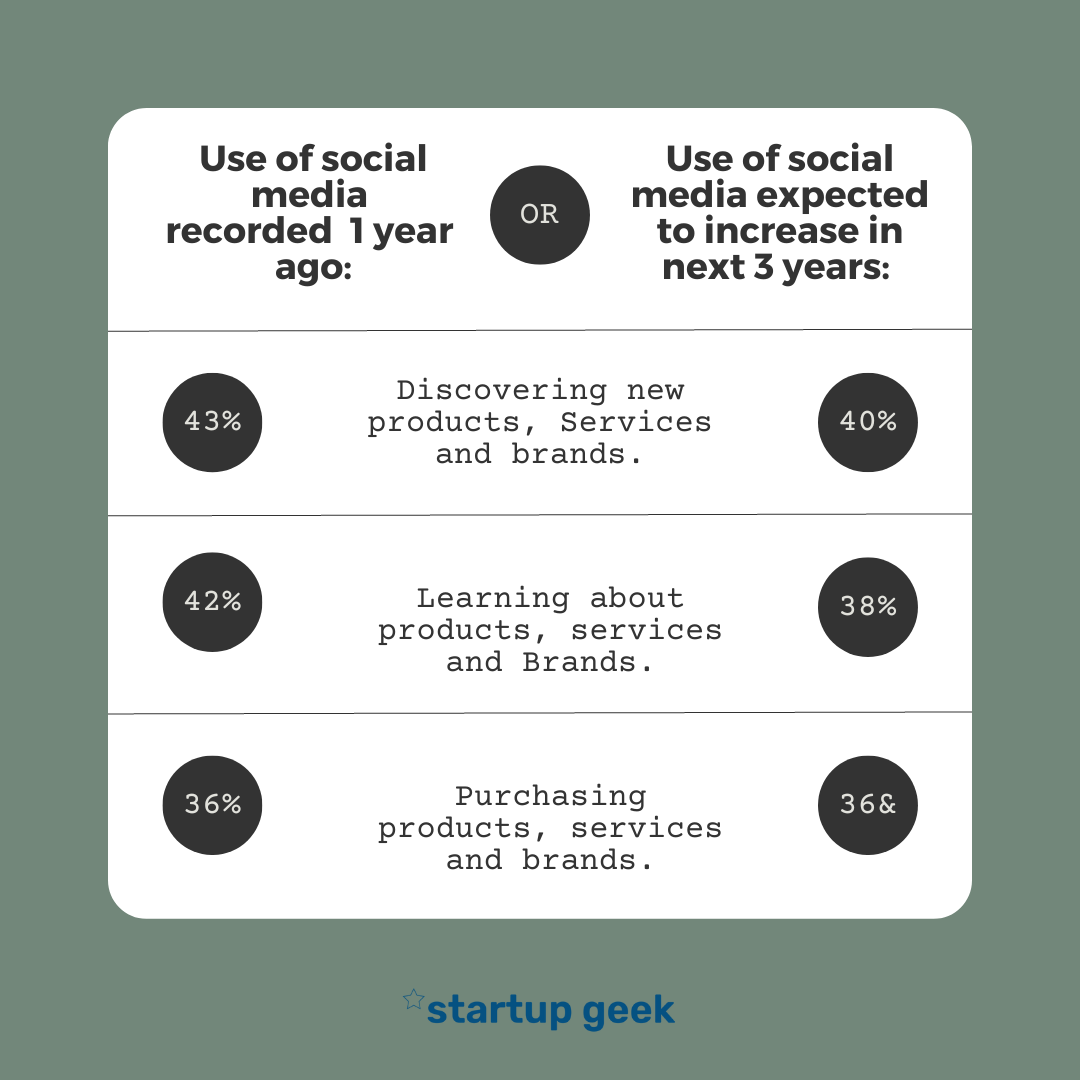
Let’s cut to the chase and dive right into some noteworthy points:
- Social media websites have a staggering 4.48 billion active users. That’s a massive audience just waiting to be tapped into.
- When it comes to daily usage, Facebook, YouTube, Pinterest and Instagram dominate the social media landscape. These platforms offer immense potential for reaching and engaging with your target audience.
- Here’s a compelling statistic: approximately 73% of marketers affirm that social media marketing (SMM) has proven to be effective for their businesses. It’s a powerful tool that can yield tangible results.

Source: Google
You might be wondering why we’re delving into these seemingly random stats. Well, they actually reveal a powerful insight: social media marketing has the potential to Launch your startup’s sales and revenue to unprecedented heights.
And that’s where social media marketing companies come into play—they are experts in helping new brands navigate the digital landscape and achieve remarkable success.
Before We Begin, We Must Define Our Core Values
It is crucial to define the core values and objectives of your social media marketing campaign. Your marketing campaign can be seen as a complex puzzle, made up of different pieces like customer feedback, market insights, and well-defined objectives.
Just like how each piece fits together to complete the puzzle, these elements work together to guide your marketing efforts. To bring this into a real-world context, consider how businesses set up dedicated Facebook pages to gather customer feedback. This feedback is a crucial piece of your puzzle, helping you understand what your audience wants and where the market trends are heading.
By regularly reviewing and responding to this feedback, you can tweak your strategies and set clear goals, similar to adjusting your puzzle-solving strategy when a piece doesn’t fit where you thought it would.
To begin this exciting voyage, let’s consider a few initial queries that will serve as our starting point:

By addressing these queries, we lay a solid foundation and gain a clear understanding of your desired outcomes. Having a defined direction allows you to steer your social media marketing efforts with precision. As you navigate the digital waves, propelled by the feedback and insights gathered, you can confidently sail towards success.
Navigating The Social Media Landscape: A 6-Step Guide To Crafting A Successful Social Media Marketing Strategy For Startups

Step 1: Choosing The Right Social Media Networks
Overview Of Different Social Media Platforms:
In this era, a multitude of social media platforms have emerged, each with its unique features, audience demographics, and communication styles. It is crucial for startups to have a comprehensive understanding of these platforms to effectively leverage them for marketing purposes.
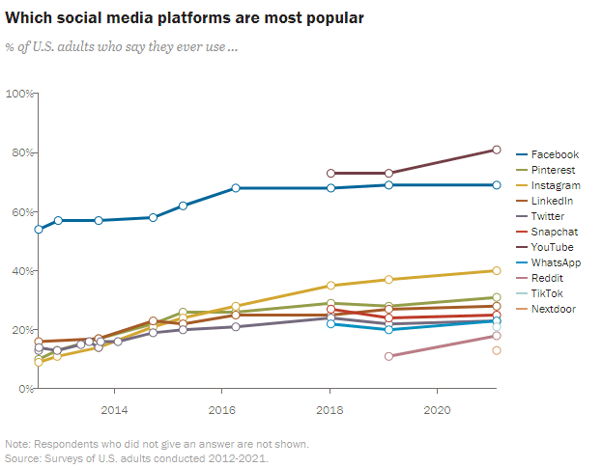
Image source: Pew Research Center
Here are some key social media platforms and their distinguishing characteristics:
- Facebook: With billions of active users, Facebook remains the largest social media platform, offering diverse advertising options, community building features, and targeted audience segmentation.
- Instagram: Known for its visually-driven content, Instagram appeals to a younger demographic and provides opportunities for brand storytelling through images, videos, and Instagram Stories.
- Twitter: As a microblogging platform, Twitter allows for real-time communication, concise messaging, and viral content sharing. Startups can leverage Twitter to engage in conversations, monitor trends, and enhance brand visibility.
- LinkedIn: Positioned as a professional networking platform, LinkedIn offers a valuable space for B2B interactions, industry thought leadership, and recruitment efforts. Startups can build professional connections, share industry insights, and establish credibility on LinkedIn.
- YouTube: As a video-centric platform, YouTube enables startups to create and share engaging video content, tutorials, product demos, and brand storytelling. It has a massive user base and offers opportunities for brand partnerships and advertising.
- TikTok: Known for its short-form videos and viral trends, TikTok provides a creative playground for startups to connect with a younger demographic. The platform’s algorithm encourages content discovery, making it an ideal place for startups to showcase their unique brand personality, engage in trending challenges, and rapidly gain exposure.
Other social media marketing platforms include:
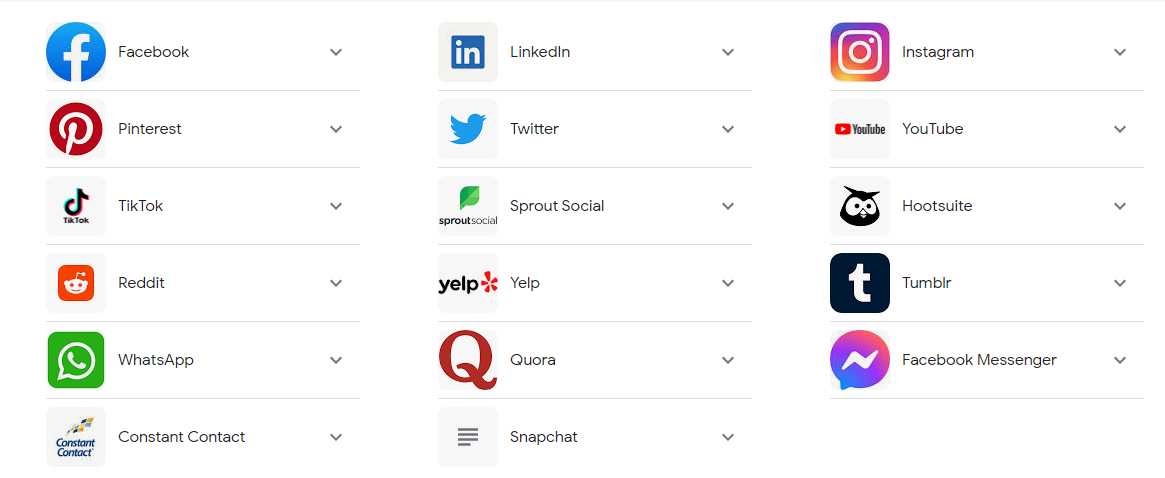
Source: Google
Step 2: Creating A Professional And Engaging Presence
When conducting a social media audit, completing your profiles is a crucial step demonstrating professionalism, consistent branding, and a commitment to meaningful engagement.
Profiles encompass two key elements: visuals and text.
Visuals should exhibit consistency and familiarity across different social media platforms. Your profile photo on Instagram should match the one on Facebook, while your cover photo on Twitter should have similarities to your cover photo on LinkedIn.
| To simplify the process, you can refer to a social network media image size chart that provides precise dimensions for each photo on various networks. Alternatively, tools like Pablo or Canva offer pre-built templates with correct sizes, making image creation easier. |
Text customization primarily focuses on the bio/info section. Crafting a compelling social media bio can be achieved by following six simple rules:

- Show, don’t tell: Highlight your accomplishments and what you have achieved rather than simply stating who you are.
- Tailor keywords for your audience: Use relevant keywords that resonate with your target audience.
- Keep language fresh: Avoid using overused buzzwords and opt for unique and engaging language.
- Answer the question of potential followers: Clearly communicate the value and benefits they can gain by following you.
- Be personal and personable: Infuse your bio with a touch of personality, making it relatable and approachable.
- Revisit often: Regularly review and update your bio to keep it relevant and aligned with your evolving goals and brand.
For Example: Let’s say you’re a budding eco-friendly coffee brand, Cuppa Green. Here’s how you might apply all the pointers in a social media bio:
“Brewing a greener tomorrow one cup at a time We’ve saved 10,000 trees and counting! By choosing Cuppa Green, you join us in our mission to make coffee-drinking sustainable. Tired of the same old brew? Discover our unique blends for a jolt of freshness each morning. Why follow us? We’ve got brewing tips, eco-hacks, and of course, plenty of coffee puns to perk up your day! Keep an eye on us, as we’re always cooking up something new to keep your coffee game strong and sustainable.”
Here, “brewing a greener tomorrow” shows an achievement, “sustainable”, “unique blends”, and “coffee game” are tailored keywords, “jolt of freshness” and “coffee puns to perk up your day” are fresh language, the question “why follow us?” is answered, a playful and personal tone is established, and the invitation to “keep an eye on us” indicates the bio’s dynamic nature, inviting revisits.
Step 3: Discovering Your Unique Marketing Voice And Tone
Before diving into social media content creation, it’s crucial to establish the voice and tone that will resonate with your target audience. This will bring consistency and compatibility between your ad spend and messaging.
While developing detailed marketing personas and analyzing your mission statement and customer base are beneficial, there are simpler ways to kickstart this process.
Consider the following questions:
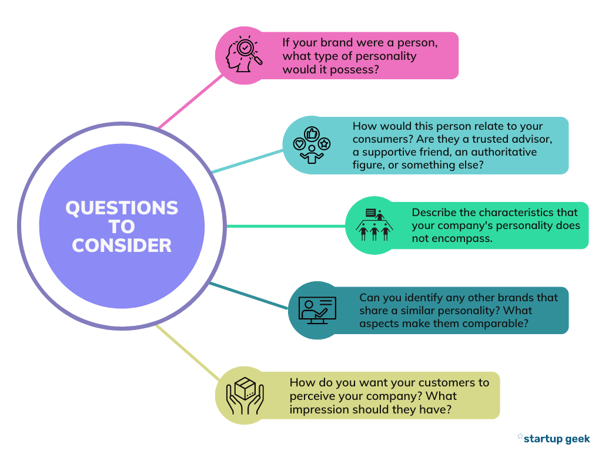
Examples: Here Are Some Additional Sources Of Inspiration And Examples To Guide You In Developing Your Marketing Voice:
- Innocent Drinks: Known for their playful and lighthearted tone, they engage their audience with witty and humorous content.

- Wendy’s: Renowned for their sassy and witty posts on facebook, Wendy’s has built a reputation for their bold and edgy brand voice.

- Dollar Shave Club: They employ a straightforward and conversational tone, using relatable language to connect with their audience.
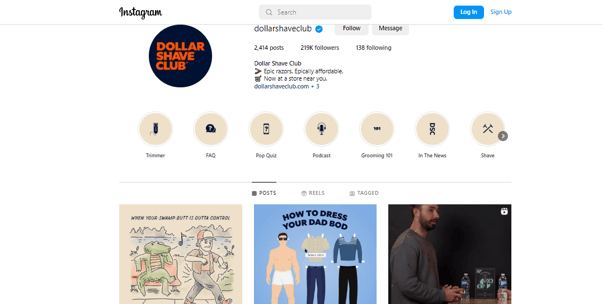
These examples showcase how brands have successfully cultivated their unique voices to captivate and engage their target customers. Remember, your marketing voice should be authentic, consistent, and tailored to resonate with your audience, ultimately inspiring them to spread the word about your brand.
Step 4: Crafting Your Posting Strategy
When it comes to determining your ideal posting frequency and timing on social media, there is no one-size-fits-all answer. It depends on your unique audience and niche.
What works for one social media platform of a brand may not work for another, so it’s essential to experiment and analyze the results (which we’ll explore in step five). However, there are some helpful guidelines to get you started on the right track.
What should you be posting? Videos are key for engagement.
The rise of video content is undeniable, as seen through the success of platforms like TikTok, Facebook, YouTube and the continuous updates to Instagram’s video features. Not only is there anecdotal evidence supporting this trend, but there is also data to back it up. For creators and marketers looking to keep up with this growing demand, leveraging a reliable video editor online can make producing high-quality, engaging videos easier than ever.
Facebook: The land of likes is also a haven for video content. Each day, Facebook videos amass a mind-boggling 8 billion views, highlighting the vast popularity of video content on the platform. Users spend about 50% of their time watching videos, affirming their deep engagement with this medium. Facebook videos boast an impressive average click-through rate of 8%, outshining other platforms in keeping viewers hooked.
Twitter: While it might be known for its 280-character limit, Twitter demonstrates that videos have a place here too. According to Sprout Social, tweets featuring videos are six times more likely to be retweeted than those with photos. They even outpace GIF-filled tweets by being thrice as likely to get retweeted, proving the potency of video content in driving user engagement and spreading the word.

Source: Sprout Social
YouTube: As the world’s second-largest search engine and a platform built around video, YouTube plays a crucial role in video marketing. Startups can harness YouTube’s massive user base to create and share a variety of video content, from explainer videos and product demos to vlogs and tutorials.
The opportunities for brand partnerships and advertising on YouTube are extensive, making it a top platform for startups to reach a global audience. We have a comprehensive video marketing guide that can help you create impactful content on YouTube.
TikTok: Known for its short, catchy videos, TikTok has taken the world by storm, especially appealing to the younger demographic. The platform’s unique algorithm and trending challenges offer startups the chance to gain rapid exposure.
Its recent addition of TikTok Shopping also presents businesses with the opportunity to drive sales directly from their videos, making it a highly engaging and increasingly commercial platform.
Frequencies And Timings For Posting:

Remember to adjust these times based on your specific Western Time zone. It’s also essential to consider your target audience’s location and their online activity patterns when determining the best posting times for your brand.
Regularly analyze your engagement metrics and utilize analytics tools provided by each platform to refine your posting strategy. (Explained in next step)
Step 5: Utilize Social Media Analytics
Data-driven decision-making is crucial in social media marketing. Startups need to monitor and analyze the performance of their social media campaigns to understand what works and what doesn’t.
Social media analytics provides valuable insights into engagement, reach, conversions, and audience behavior. By leveraging the power of social media analytics, startups can refine their strategies and optimize their content.
Here are some ways to utilize social media analytics effectively:
Track Key Metrics:
Startups should identify the key performance indicators (KPIs) relevant to their goals, such as likes, comments, shares, click-through rates, conversion rates, and website traffic. By monitoring these metrics, startups can evaluate the success of their campaigns and make data-driven decisions.

Source: Google
Utilize Native Analytics Tools:
Each social media platform offers its analytics tools that provide in-depth data and insights. Startups should explore these tools to track their performance, identify trends, and understand audience demographics and behaviors. Here are some Screenshots from Instagram’s native analytics tool.
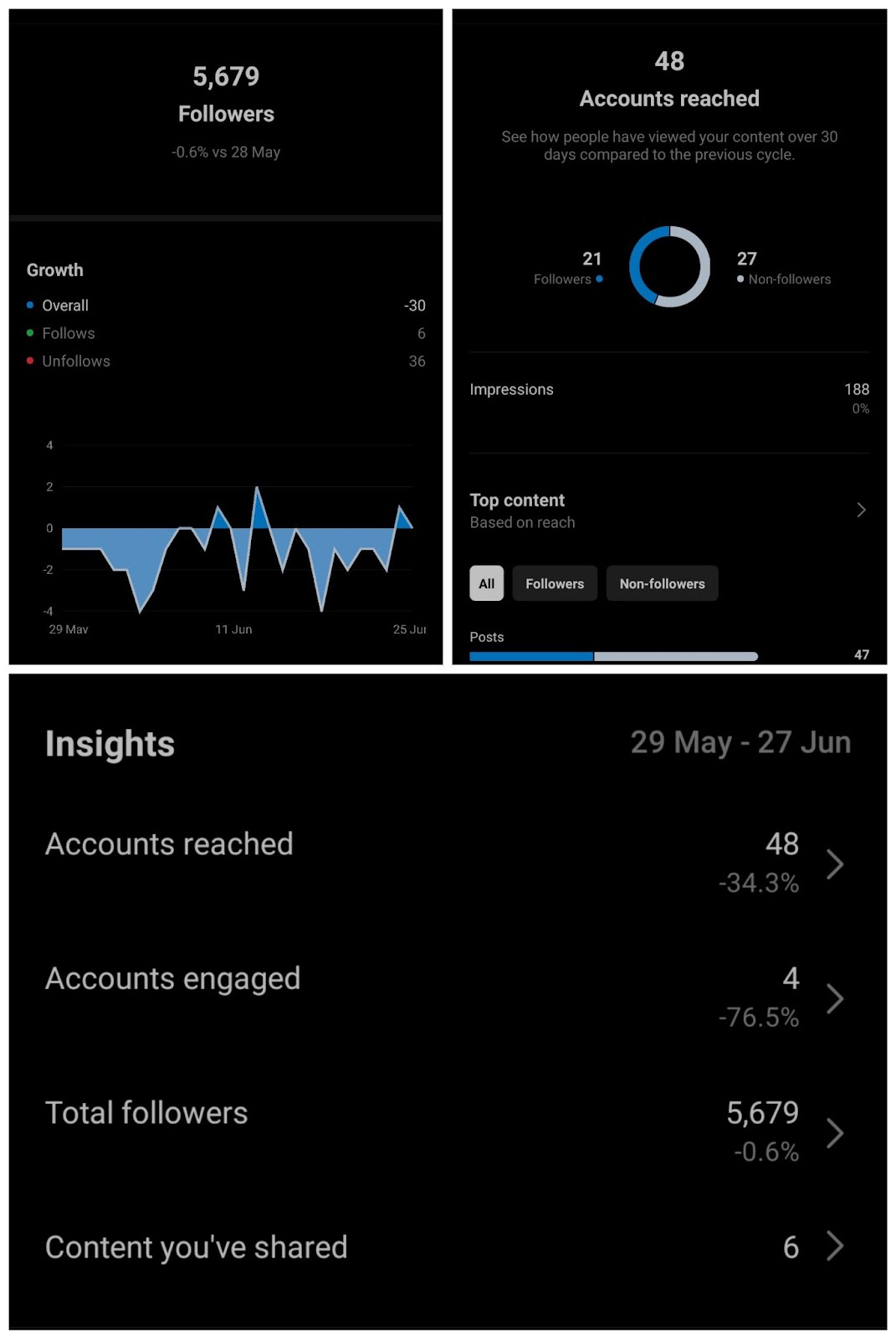
Use Third-Party Analytics Tools:
In addition to native analytics, startups can also leverage third-party analytics tools to gain a holistic view of their social media performance. These tools offer advanced analytics, competitor analysis, sentiment analysis, and benchmarking, providing a comprehensive understanding of the social media landscape.

Source: Google
Step 6: Automation, Engagement And Listening For Brand Success
It’s crucial to have a system in place to manage your social media updates and actively engage with your community. This involves automating your posting schedule, staying engaged in conversations, and listening to what people say about your brand.
Start by leveraging automation tools like Hootsuite and Mention, you can create and schedule posts in advance, select the specific date and time for each blog post, and even target specific audience segments.
They gather all social media mentions, comments, and messages related to your brand in one central location, allowing you to promptly respond and engage with your followers providing a friendly user interface.

However, automation alone is not enough. Social media also requires active engagement.
| Take the time to respond to comments, messages, and mentions from your audience. These interactions are opportunities to connect with potential customers, build relationships, and showcase your brand’s personality. |
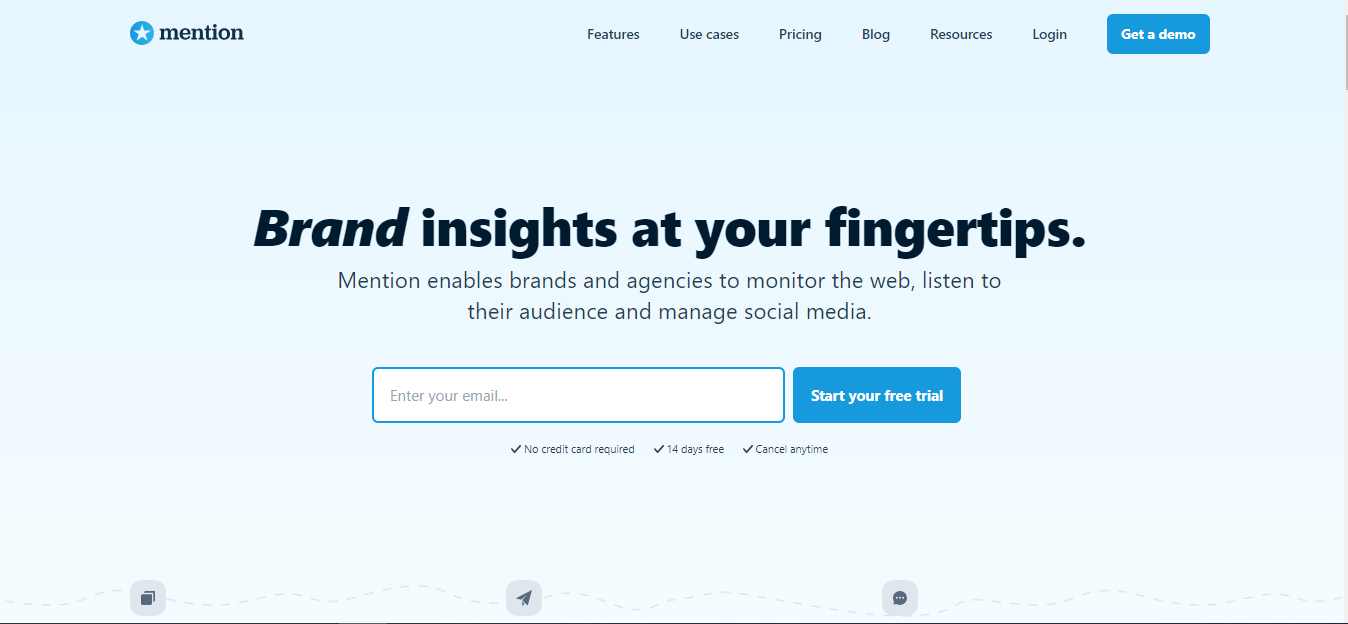
Remember, these conversations are valuable and should not be ignored. Set aside dedicated time each day to interact with your audience, whether it’s addressing inquiries, providing support, or simply showing appreciation for their engagement.
By actively engaging with your community, you demonstrate your commitment to building relationships and fostering a positive brand image.
Speaking Of Brand Image, Let’s Talk About: Building Brand Awareness
Brand awareness is the primary factor that underscores the importance of social media marketing for startups. Many global brands rely solely on social media channels such as Facebook and Instagram to actively market their businesses.
The Success Story Of Glossier:
Glossier, a renowned beauty and skincare brand, effectively utilizes social media platforms like Instagram and TikTok. Through visually appealing content and active engagement with their followers, Glossier has built a strong online presence, resulting in increased brand awareness and significant sales growth.
Their social media marketing strategy has created a passionate community of brand advocates, propelling Glossier to become a leader in social media marketing courses in the beauty industry.

In addition to global brands, even local businesses recognize the value of social media, with 93% relying on these platforms for brand awareness. Considering the billions of users who access social media channels daily worldwide, it becomes evident that they serve as prime marketing hubs for businesses.
By utilizing social media, startups can tap into a vast audience, raising their brand visibility and attracting potential customers.

Source: Socialpilot
Another important aspect is knowing the right audience for your startup.
How To Target The Right Audience
One of the key aspects of social media marketing for startups is identifying and targeting the right audience. It involves understanding the demographics, preferences, behaviors, and pain points of the target audience.
By defining a specific target audience, startups can tailor their content, messaging, and advertising efforts to resonate with their ideal customers.
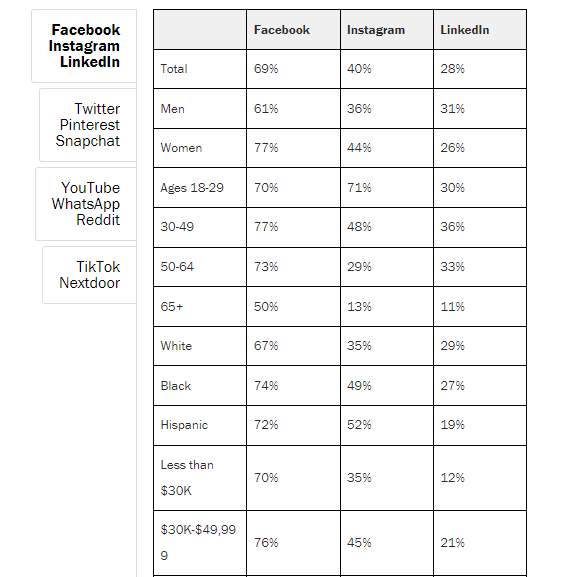
Image course: Pew Research Center
Here are some strategies to effectively target the right audience:
Conduct Market Research:
Startups can utilize market research techniques to gather insights about their target audience. This includes analyzing demographic data, conducting surveys or interviews, and monitoring social media conversations to gain a deeper understanding of their audience’s needs and preferences.
Define Buyer Personas:
Creating buyer personas helps in visualizing and understanding the ideal customers. Startups can develop detailed profiles encompassing demographic information, motivations, challenges, and preferred communication channels. This helps craft targeted content and messaging that resonates with the intended audience.
Utilize Audience Segmentation:
Social media platforms provide tools and features to segment the audience based on various parameters such as age, location, interests, and behaviors. Startups can leverage these segmentation capabilities to target specific groups with tailored content and advertisements.

Image source: Pew Research Center
Empowering Relationships: Direct Customer Communication And Cost-Effective Traffic Generation Through Social Media
Having Direct Communication With Customers
Communication plays a vital role in fostering strong relationships, which holds true for the relationship between consumers and suppliers. Social media platforms have revolutionized this dynamic by eliminating the need for intermediaries. Brands now have the opportunity to engage directly with their customers.
In the current digital era, social networks like Google have become popular platforms for product searches and service inquiries. In fact, a staggering 90% of customers have used social media channels to connect with brands.

Source: Google
Furthermore, 63% of users expect brands to provide customer service through social networks.

Source: Google
Therefore, it’s essential for brands to not only focus on building their brand value but also leverage social media to gather customer feedback and promptly address any issues or concerns.
By actively engaging with customers on most social media platforms, brands can establish a direct line of communication, strengthen customer relationships, and enhance overall customer satisfaction.
Driving High Traffic At Low Costs
Startups often face resource constraints, making it crucial to allocate their budget wisely when planning a marketing strategy. While traditional marketing media avenues can be expensive, According to a survey by eMarketer, 91% of marketers believe that social media marketing is effective for their business, indicating its cost-effective nature and potential for delivering favorable results.
One advantage is its flexibility in budget allocation, as platforms like Facebook and Instagram allow advertisers to set their own spending limits. Additionally, even without paid campaigns, taking an organic approach can still yield favorable results.
In fact, a study conducted by Buffer found that 86% of small businesses find social media marketing to be a cost-effective method.
According to Statista’s data as of April 2023, the number of internet users worldwide reached 5.18 billion, which accounted for approximately 64.6 percent of the global population. Out of this total, a staggering 4.8 billion individuals, representing 59.9 percent of the world’s population, were active users of social media platforms.
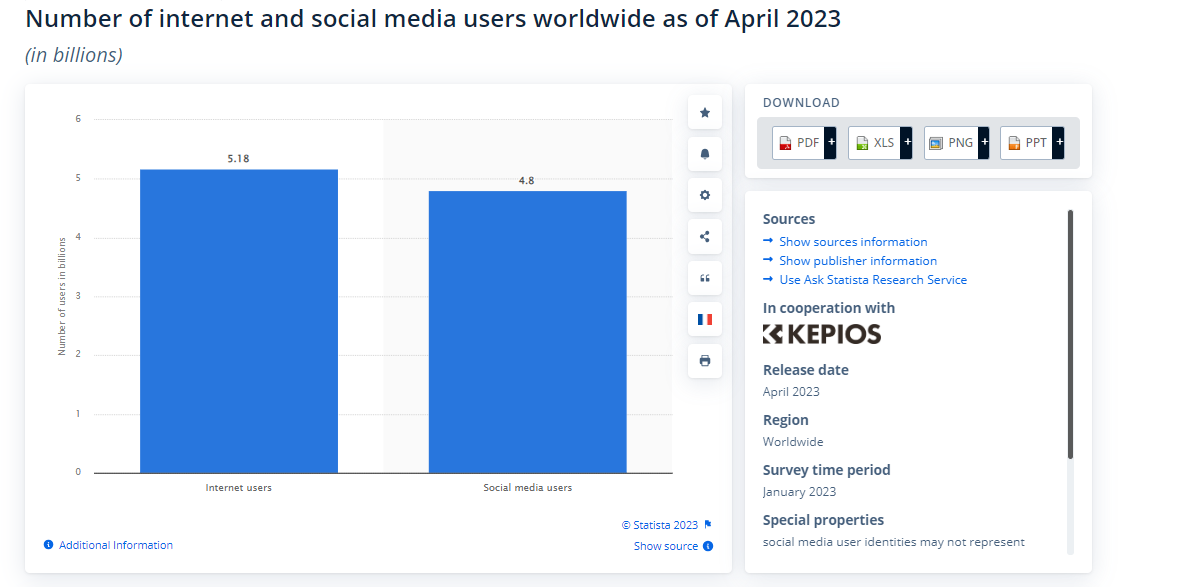
Source: Statista
When executed correctly, a social media marketing plan can deliver a higher return on investment by attracting an audience with a higher likelihood of converting into customers. Compelling visual content is particularly effective in capturing users’ attention.

Source: Google
Maximizing Social Media Marketing Potential: Influence, VR, Live Streaming And UGC
1. What Is Influence Marketing And Why Do We Need It?
Influence marketing, also known as influencer marketing, is a form of social media marketing that involves collaborating with influential individuals or content creators with a dedicated and engaged following. These social media influencers have the ability to sway the opinions and purchasing decisions of their audience.

Source: Google
How Does It Help Startups?
Influence marketing, when executed strategically, can be a valuable tool for startups in social media marketing, helping them to expand their reach, build trust, and drive engagement with their target audience.
Influence marketing helps startups in social media marketing in several ways:
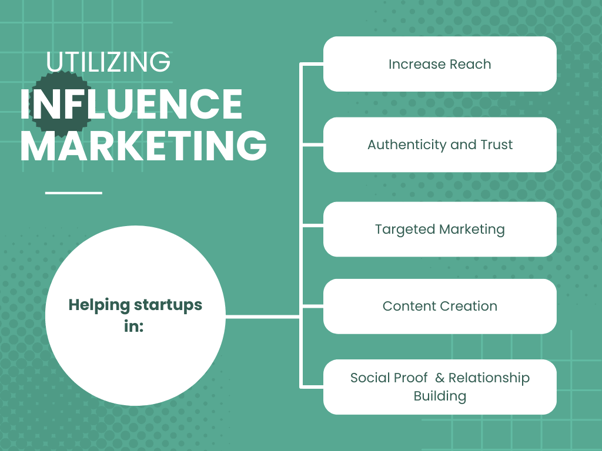
- Increased Reach: Collaborating with influencers allows startups to tap into the existing audience of these influencers, which is often large and diverse. This provides startups with an opportunity to reach a wider and more targeted audience, increasing their brand visibility and awareness.
- Authenticity and Trust: Influencers typically have a strong connection with their followers, built on trust and credibility. When an influencer promotes a startup’s product or service, their audience perceives it as a genuine recommendation rather than a traditional advertisement. This authenticity helps in building trust and credibility for the startup. 87% of consumers read online reviews to determine the quality of a business
- Targeted Marketing: Influencers often have a specific niche or audience segment they cater to. By carefully selecting influencers who align with their target market, startups can ensure that their message reaches the right audience. This targeted approach increases the chances of attracting potential customers who are more likely to be interested in the startup’s offerings.
- Content Creation: Influencers are skilled content creators who understand their audience’s preferences. When collaborating with influencers, startups can benefit from their expertise in creating engaging and high-quality content that resonates with their target audience. This content can be repurposed and shared across various social media platforms, boosting the startup’s social media presence.
- Social Proof: Influencers’ endorsements and positive experiences provide social proof for startups. This boosts potential customers’ trust and perception of the startup, influencing their decision-making process. According to a survey by Nielsen, 92% of consumers trust recommendations from individuals, even if they don’t know them, over brand advertisements.
- Relationship Building: Partnering with influencers allows startups to establish relationships with key individuals in their industry or niche. These relationships can extend beyond a single campaign and lead to long-term collaborations and brand advocacy. Startups can leverage these relationships to gain further exposure and credibility in their market.

Source: Google
2. What Is Virtual Reality And Why Do We Need It?
Virtual reality (VR) refers to a computer-generated simulation or immersive experience that can replicate real or imaginary environments. It typically involves wearing a VR headset or using VR devices to interact with and explore these virtual worlds. Here are some stats for you to ponder upon.

Source: Google
How Does It Help Startups?

Virtual reality can greatly benefit startups in social media marketing in the following ways:
- Enhanced Brand Engagement: VR allows startups to create immersive and interactive experiences for their audience. By leveraging VR technology, startups can provide unique and memorable brand experiences that go beyond traditional social media content. This increased engagement helps in capturing the attention of users and creating a lasting impact.

Source: Google
- Personalized and Interactive Content: VR enables startups to create personalized and customized experiences for their audience. Through VR, startups can offer interactive product demonstrations, virtual tours of their facilities, or even virtual try-on experiences. This level of interactivity and personalization helps drive user engagement and can lead to increased interest and conversion rates.

Source: Google
- Storytelling and Emotional Connection: VR provides startups with a powerful medium to tell their brand story and evoke emotional connections with their audience. By creating immersive narratives and experiences, startups can captivate users’ attention and leave a lasting impression. VR allows for a more immersive and sensory-rich storytelling experience, enhancing the emotional impact of the brand message.
- Differentiation and Innovation: By embracing VR technology in their social media marketing efforts, startups can differentiate themselves from competitors and position themselves as innovative and forward-thinking brands. Incorporating VR into marketing campaigns showcases the startup’s willingness to embrace new technologies and deliver cutting-edge experiences, helping them stand out in a crowded market.
- Viral Potential and Social Sharing: VR experiences have the potential to go viral and generate significant social media buzz. Users are often eager to share their unique and immersive VR experiences with their social networks, leading to increased brand visibility and organic reach for startups. This viral potential can significantly amplify the impact of a startup’s social media marketing efforts.

Source: Google
- Data and Insights: VR experiences can provide startups with valuable data and insights about user behavior and preferences. By tracking user interactions within a VR environment, startups can gain valuable feedback and insights to inform their marketing strategies and product development.
Overall, virtual reality opens up new opportunities for startups in social media marketing by enabling immersive brand experiences, personalized content, emotional connections, and differentiation.
By leveraging VR technology, startups create engaging content experiences that leave a lasting impact on their audience, helping them effectively build their brand and drive business growth. Here are some more stats to consider.
3. What Is Live Video Streaming And Why Do We Need It?
Live video streaming refers to the real-time broadcasting of video content over the internet to an audience. It allows individuals or businesses to share live video footage, presentations, events, or interactions with their followers and viewers.
How Does It Help Startups?

Live video streaming can significantly benefit startups in social media marketing in the following ways:
- Authentic and Engaging Content: Live video streaming offers an authentic and unfiltered way to connect with an audience. Startups can use live video to showcase behind-the-scenes footage, product demonstrations, interviews, Q&A sessions, or live events. This real-time interaction creates a sense of immediacy and authenticity, which can engage viewers and build a deeper connection with the brand. According to a survey by Stackla, 86% of consumers believe that authenticity is a key factor when deciding which brands to support.

- Increased Reach and Engagement: Live video streams often receive higher engagement rates compared to other types of content. The real-time nature of live videos encourages viewers to actively participate through comments, likes, and shares. This increased engagement can help startups reach a wider audience, attract new followers, and increase brand visibility on social media platforms.
- Cost-Effective Marketing: Live video streaming eliminates the need for elaborate production and editing, making it a cost-effective marketing strategy for startups. With a smartphone or a computer equipped with a webcam, startups can easily go live and deliver valuable content to their audience without significant investments in equipment or post-production.
- Immediate Feedback and Interaction: Live video streaming enables startups to receive immediate feedback from their audience. Viewers can ask questions, provide comments, and engage in real-time conversations during the live stream, fostering six times more interaction. This direct interaction allows startups to gather valuable insights, address concerns, and tailor their messaging based on the audience’s reactions and preferences.
- Fostering Transparency and Trust: Live video streaming allows startups to demonstrate transparency and build trust with their audience. By showcasing real-time activities, updates, or product demonstrations, startups can instill confidence in their brand, products, and services. Transparency in live videos can help establish credibility and loyalty among viewers.

Source: Google
- Repurposing Content: Live video streams can be repurposed and shared across multiple platforms and channels. Startups can save the recorded live videos and publish them on their social media profiles, websites, or YouTube channels. This extends the lifespan of the content and allows startups to reach a broader audience who may have missed the live stream. 68% of marketers believe that repurposing content increases audience engagement.
- Event Promotion and Coverage: Startups can use live video streaming to promote and cover events they host or participate in. Whether it’s a product launch, a conference, or a networking event, live streaming allows startups to share the experience with their audience, even if they can’t physically attend. This helps in generating buzz, attracting interest, and showcasing the startup’s activities to a wider audience.

Image source: Livestream
4. What Is User Generated Content (UGC) And Why Do We Need It?
User-generated content (UGC) refers to any form of content, such as text, images, videos, reviews, or testimonials, that is created and shared by individuals who are users or customers of a brand.
It is content that is voluntarily produced by the users rather than paid or organic content created by the brand or its marketing team.
How Does It Help Startups?
UGC can significantly benefit startups in social media marketing in the following ways:
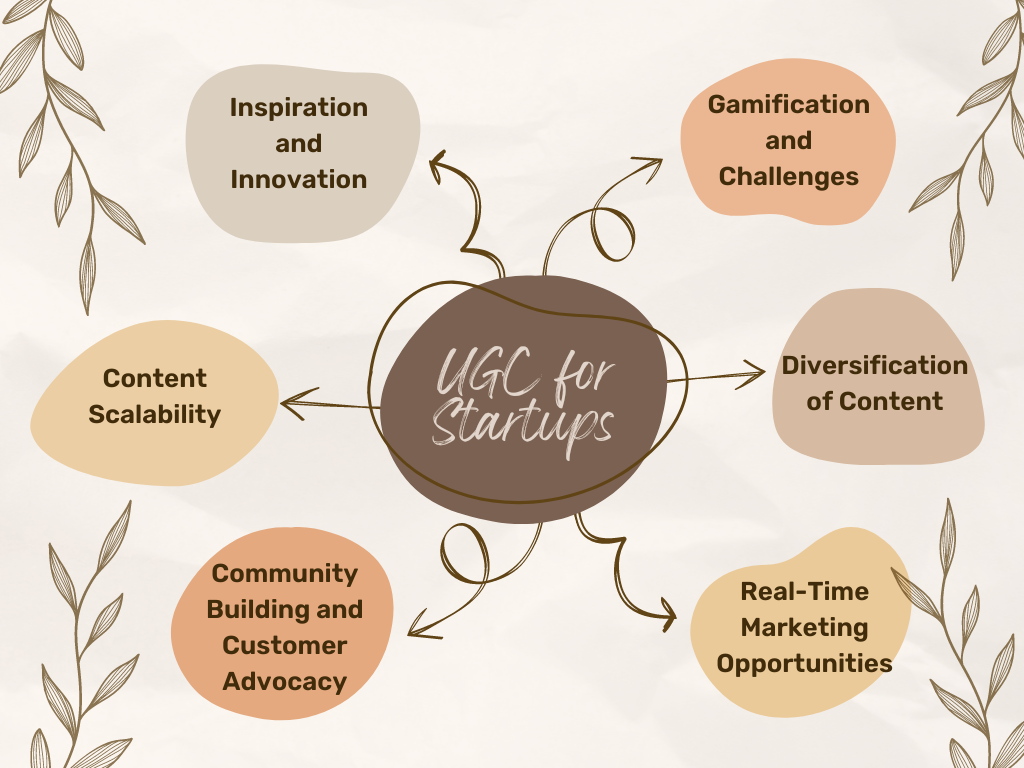
- Inspiration and Innovation: User-generated content can inspire startups by showcasing creative and innovative ways customers use their products or services. Startups can gain new ideas and perspectives from UGC, leading to product enhancements or the development of new offerings. 90% of consumers say that user-generated content is extremely influential in purchasing decisions.
- Gamification and Challenges: Startups can incorporate gamification elements and challenges into UGC campaigns to encourage participation and engagement. By creating contests, quizzes, or interactive challenges, startups can motivate users to generate and share content on social media, fostering a sense of fun and excitement around the brand. A study by Badgeville found that gamified experiences can increase participation by 93%.

Image source: LXA
- Diversification of Content: User-generated content adds variety and diversity to a startup’s social media presence. By featuring content their customers create, startups can showcase different perspectives, styles, and experiences, ensuring their social media feeds remain fresh and engaging.
- Real-Time Marketing Opportunities: User-generated content enables startups to tap into real-time marketing opportunities. When users share content related to trending topics, events, or challenges, startups can leverage these moments to create timely and relevant social media campaigns. This agility in responding to current trends helps the startup stay relevant and resonate with its audience. 53% of consumers follow brands on social media to stay updated with the latest news and trends.
- Community Building and Customer Advocacy: UGC fosters a sense of community among users and customers. When users contribute content and engage with the startup’s brand, it creates a sense of belonging and encourages customer loyalty. User-generated content can also lead to customer advocacy, as satisfied users become brand advocates who actively promote the startup’s products or services to their own networks. User-generated content is 35% more memorable and 50% more trusted than other media types.
- Content Scalability: User-generated content provides a scalable solution for content creation. As startups grow, it becomes increasingly challenging to generate a continuous stream of high-quality content. UGC allows startups to tap into the creativity and enthusiasm of their customers, ensuring a consistent flow of engaging content without putting excessive strain on internal resources.

Source: Google
Overall, user-generated content empowers startups to leverage the creativity, experiences, and influence of their customers to enhance their social media marketing efforts. It not only creates a sense of authenticity and trust but also fosters engagement, expands reach, and builds a loyal community around the startup’s brand.
3 Easy Tips For Enhancing Social Media Marketing Strategies:
Now that you have a grasp of the fundamentals and strategies of social media marketing, you can elevate the effectiveness of your Social Media marketing campaign by combining it with other marketing techniques. Here are several activities that can be integrated to amplify Social Media Marketing practices and efforts:
- Retargeting: Once you have successfully attracted a substantial amount of traffic to your website through regular ads, the next step is retargeting. Retargeting ads have been shown to achieve an average click-through rate (CTR) 10 times higher than regular ads. Therefore, it is crucial to prioritize this aspect as well.
- Email marketing: It involves reaching out to potential clients via email to promote your products and services. Implementing email marketing in conjunction with your SMM campaign can be advantageous, given that the market for email marketing is projected to reach $9 billion by 2027.
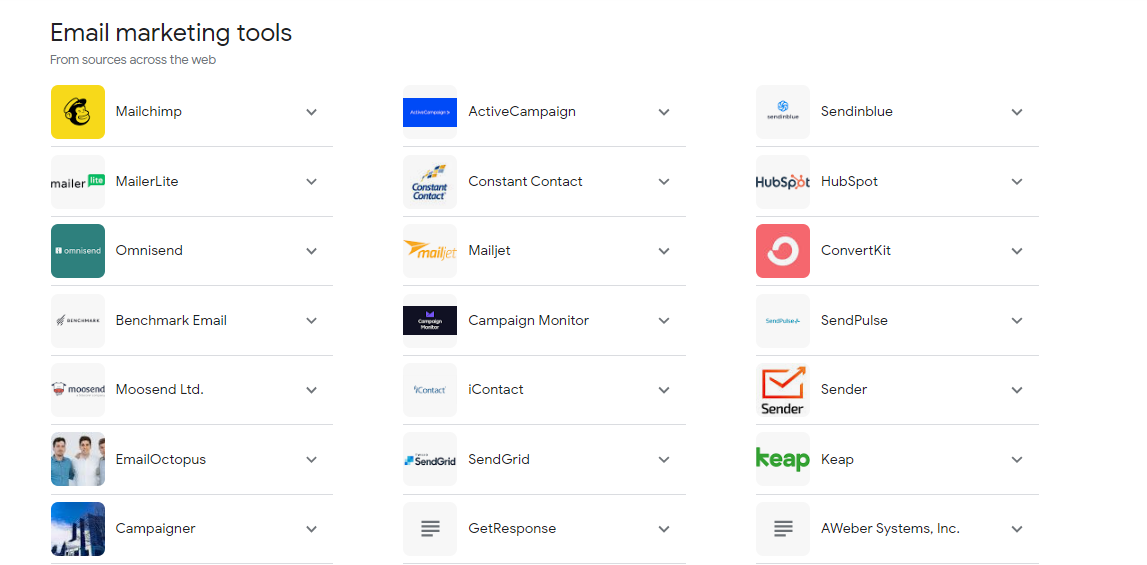
Source: Google
- SEO: As previously mentioned in the reasons to choose SMM, search engine optimization (SEO) plays a significant role in content creation for your marketing campaign. By incorporating relevant keywords and phrases into your content, you can enhance your website’s ranking in Google search results, thereby increasing its visibility and accessibility.
Wrapping Up
Social media marketing goes beyond mere connection; it’s about forging meaningful relationships. It can be a powerful tool for startups to reach their target audience and grow their business.
Defining your target audience, choosing the right platforms, creating engaging content, and measuring success are all crucial steps in developing a successful social media strategy.
Remember to stay consistent with your branding and messaging across all platforms, and always be open to adapting and improving your strategy as needed. By doing so, you can build a strong online presence and connect with your audience meaningfully.
In essence, social media marketing enables startups to create lasting connections, generate brand loyalty, and drive sustainable growth in a digitally-driven world.

